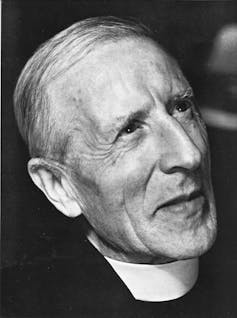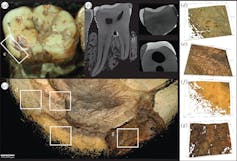In 1912 it was announced that some remains of “the earliest Englishman” had been found in a gravel pit. This “hominid”, Eoanthropus dawsoni, became known as the Piltdown Man.
About 50 years later, South African anatomist Joseph Weiner exposed the Piltdown Man as a hoax. He revealed that a human skull and a modern orangutan jaw, both stained brown, had been deposited together in the gravel pit.
Weiner and his colleagues named Charles Dawson, a lawyer and amateur archaeologist based in Sussex, as the prime suspect in the forgery. Dawson claimed that his involvement in Piltdown had started when workers digging for gravel found the skull fragments and handed them to him.
It later emerged that Dawson was responsible for more than 30 forgeries. It is speculated that Dawson committed these in the hope of becoming a Fellow of the Royal Society – a distinction he never achieved.
Dawson’s role in the Piltdown Man hoax appears to have been confirmed in 2016 by palaeo-anthropologist Dr Isabelle de Groote and her colleagues. High-tech forensic analyses led them to conclude that only a single hoaxer, presumably Dawson, was responsible. The case seems closed. But is it?
Research I have conducted recently and published in the South African Journal of Science suggests that Dawson may not necessarily have been the culprit in this particular case.
I suspect someone realised that Dawson was a fraudster and decided to play a joke on him. Archival research in London and Paris leads me to believe that a French Jesuit priest was in on the joke – which went terribly wrong after palaeontological experts mistook Piltdown Man for the real thing.
This is a reminder that palaeontologists should always be extremely vigilant and thorough in ensuring that fossil finds are authentic.
A religious joker?
So who was this joker?
Pierre Teilhard de Chardin was a French Jesuit based at Ore Place, a theological seminary nears Hastings in Sussex. As a young man he longed to become a professional palaeontologist. The seminary was within 50 kilometres of Piltdown, where Teilhard contributed to excavations in an amateur capacity.
In January 1913 De Chardin wrote an essay beginning with the words
There was a time when the study of prehistory deserved to be suspect, and deserved to be the subject of jokes.
His essay is about the current understanding of human evolution, but most strangely – and suspiciously – he omits all reference to the Piltdown Man even though its discovery had been officially announced just three weeks earlier.
Almost immediately after the Piltdown announcement, Teilhard wrote to his Jesuit friend Felix Pelletier, with whom he had collected fossils in Sussex:
We must do nothing. We must wait for the criticisms that will follow. Marcellin Boule [an eminent French prehistorian] will not be taken in, especially because the finds are English.

This convinced me Teilhard knew from the very beginning that Piltdown Man was not genuine. I am not, I should point out, the first to suspect him.
Distinguished scientists like Louis Leakey and Stephen Jay Gould have previously suggested that Teilhard was involved in the Piltdown case. Gould was strongly suspicious about Teilhard because the hinge between the jaw and the skull – known anatomically as the condyle – was broken. In 1920 Teilhard had stated that the Piltdown mandible might have been deliberately broken (comme par espres, “as if on purpose”).

Gould thought this was tantamount to Teilhard admitting that he knew of the forgery long before anyone else suspected it. If the condyle had been preserved in the case of the Piltdown jaw, it would have been immediately recognised that it could not possibly have articulated with the human skull.
In 1977 Kenneth Oakley, a palaeontologist at the British Museum of Natural History, told me he was giving Teilhard the benefit of the doubt – because he was a priest. But Oakley also told me that Teilhard appeared to be agitated and very reluctant to talk about Piltdown when he was shown the evidence that led to the exposure of the hoax.
Another famous palaeontologist, Phillip Tobias, said Teilhard was known as a joker.
It is important to emphasise that both Teilhard and Martin Hinton, a palaeontologist at the British Museum, said they knew who the Piltdown perpetrator had been. But neither disclosed this person’s identity – except to say that it was not Dawson. So were Teilhard, Hinton and a third “Person X” complicit in a joke, directed against Dawson?
A strange cast of characters
The Piltdown orangutan jaw came from Borneo. It is probable that the jaw originated from an 1878 expedition. Most of the material collected on that trip was deposited in the British Museum of Natural History. But “duplicates” could have been distributed elsewhere, subject to a committee’s decision, as mentioned in a paper by archaeologist Andrew Sherratt.
It would seem that such “duplicates” could have been distributed to donors of the expedition, including members of the Willett family who lived in Sussex.
Edgar Willett was trained at Oxford. He practised as an anaesthetist and served as a curator of a museum with expertise in anatomy. He was also at Piltdown with Dawson at some point in time.
Willett is a common name in the area of Ore in Sussex, and it was at “Ore Place” where Teilhard de Chardin was based between 1908 and 1912 – the very years in which Piltdown material was initially collected.
Did Teilhard know about a Piltdown joke through Edgar Willett who, as an anatomist, could have had access to an orangutan jaw and other specimens in a private collection or museum? And could Edgar Willett have been in a position to facilitate a joke against Dawson with Teilhard as an adviser? Was Willett “Person X”?
In a letter to the palaeontologist Kenneth Oakley dated November 28 1953, Teilhard wrote:
Would it have been impossible for some collector who had in his possession some ape bones, to have discarded specimens into the pit? The idea sounds fantastic. But, in my opinion, no more fantastic than to make Dawson the perpetrator of the hoax.
In another letter to a famous French prehistorian, the Abbe Henri Breuil, dated December 8 1953, Teilhard wrote:
I have difficulty in accepting a hoax on the part of Dawson…and as fantastic as it seems, I admitted rather that someone threw, innocently, from the cottage nearby, some “collection” in the “Pit” of Piltdown"
In these two separate letters, Teilhard is probably being absolutely honest about a “collection” which included an ape such as an orangutan. But was he joking when he suggested that someone “innocently” threw part of such a collection into the Piltdown pit?
A joke gone wrong
To my mind, we need to take another close look at the Piltdown case. Perhaps Dawson was hoist with his own petard: someone realised that he was a habitual forger and sought to beat him at his own game. If this is indeed the case, Dawson may be considered a victim of a joke that went terribly wrong. It won’t repair his blighted reputation, though: he’ll still go down in history as a fraudster who hoped to boost his own career through forgeries.

